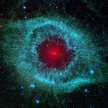Is Life on Earth Unique in the Universe?
It is highly unlikely that the statement above is true, but will we ever know for sure if we are indeed alone in that gargantuan area we call the universe?

British spelling
Here are two of my stories regarding the universe and life. Enjoy.
Due to all the scientific evidence that we have gained, most scientists, astrophysicists, and astronomers agree on how the universe has evolved from its birth right up to the present day.
<><><>
1/2
Are we alone?

The universe is thought to have come into existence 13.8 billion years ago; that amazing event is sometimes called the Big Bang.
But if you were to ask any highly educated person who is in this field of work the question, "What existed before the Big Bang?" Their truthful answer would be that they simply don't know.
As of now, there is no scientific way to find out. Maybe our universe is just one of countless universes somewhere out there in the unknown.
For the moment, we will have to be content with the many conflicting ideas and theories that are available on the subject.
As we don't know all the answers, it can become frustrating for those of us who take an avid interest in what has transpired in the past and what could occur in the future.
Encouragement for me is knowing that thousands of professionals, using highly advanced scientific equipment here on Earth and in outer space, continue to gain more factual information about the beginning of the universe and how it has evolved over billions of years.
I doubt if I have enough time left for someone to provide me with the answers I seek, but I do believe that considering the speed of ongoing scientific advances, young people living now will get more of the important questions answered in their lifetimes.
I do believe there are other life forms somewhere out there in the universe. Surely the odds against there being no other life are just too big. But having said that, could it be possible that the Earth is so unique and special that it is the only world to harbour intelligent life?
I must admit that there had to be a very large number of perfect conditions that converged in the right way and at the right time for life to get started and flourish in our magical world.
If any of these forces, such as gravitational force, electromagnetic force, strong nuclear force, or weak nuclear force, had been slightly stronger or weaker, we as a species would probably not exist.
<><><>
2/2
The Sun is tiny in comparison to many other stars.
The Solar System is estimated to be more than 4.5 billion years old. At its centre is an average G-type main-sequence star or yellow dwarf star, which we call the Sun.
Although our closest star, the sun, is the main reason we exist, most of us give it little thought as we live out our lives on this magical planet.
The sun is nothing special when compared with other stars; some stars are smaller, but many stars have unimaginable sizes.
Stephenson 2–18 is arguably the largest star known at this time. It lies 18,900 light-years from the Earth. But remember, light travels 1,080 million kilometres per hour, or 9.46 trillion kilometres in a year. Yes, this star is very far away by our standards.
How can we visualise the size of Stephenson 2–18 when comparing it to the Sun? This gigantic star has a diameter that is 2,150 times that of the Sun.
The Sun has a diameter of 1,392,680 kilometres, so using a simple sum, the diameter of Stephenson 2–18 works out to 2,994,262,000 kilometres.
When we use large numbers, it becomes difficult for us to comprehend.
Maybe the next paragraphs will help in understanding how big this star is.
As you probably know, eight planets orbit the Sun: Mercury, Venus, Earth, Mars, Jupiter, Saturn, Uranus, and the farthest-away planet Neptune.

Now you will have to use your imagination!
Replace the Sun with Stephenson 2–18 so it is in the same position at the centre of the solar system. That would be very bad news for all the planets, especially the five closest to the Sun and possibly the sixth planet Saturn; they would all be inside the giant star.
Light travels at almost 300,000 kilometres per second. If it were possible to travel around the circumference of the sun, it would take light 15 seconds; to travel around the circumference of Stephenson 2–18, it would take light an incredible 8.7 hours.
Anything that has mass could never reach the speed of light; it could be the reason we will never be able to leave our local area in space.
We have never heard from intelligent extraterrestrials; they too might be restricted to their small area in space. That is if they do exist.
The end.
<><><>
You may find my easy-to-understand stories about the universe and life interesting and educational.
If you subscribe to me for free, you will see my latest stories. Regards.
Free to read.
About the Creator
Unravelling the Universe
We can only imagine what our early ancestors thought as they gazed up at the night sky—were they curious about what the heavens had to hide?






Comments
There are no comments for this story
Be the first to respond and start the conversation.